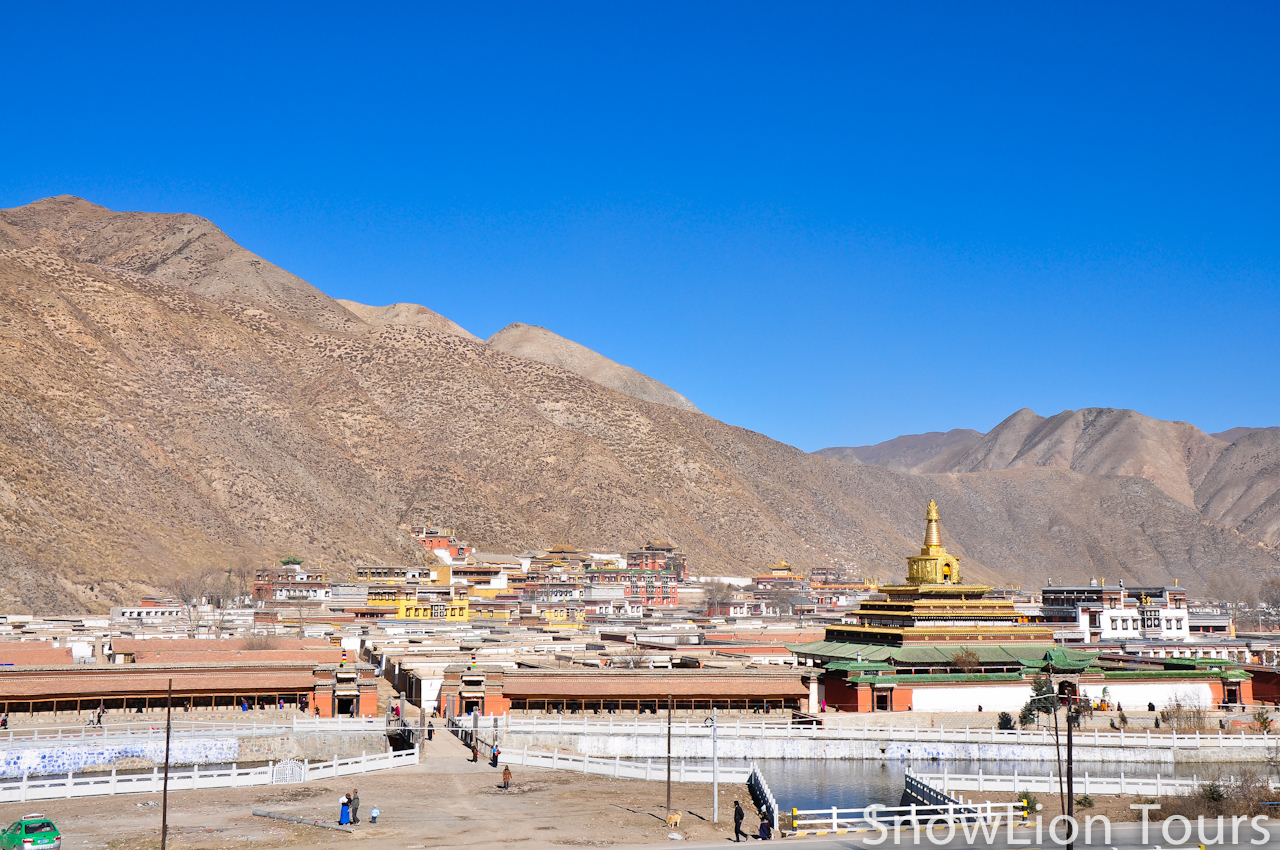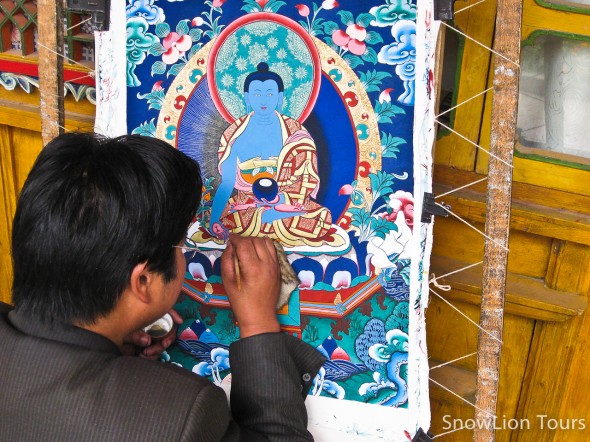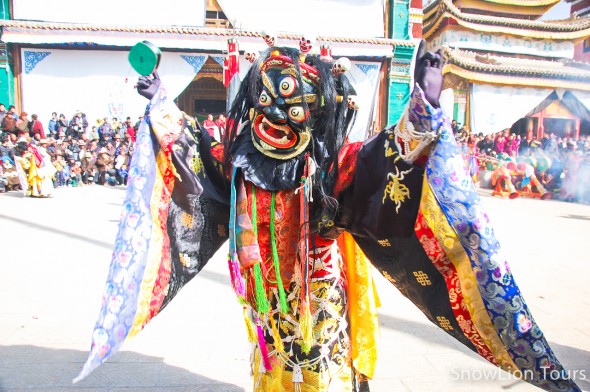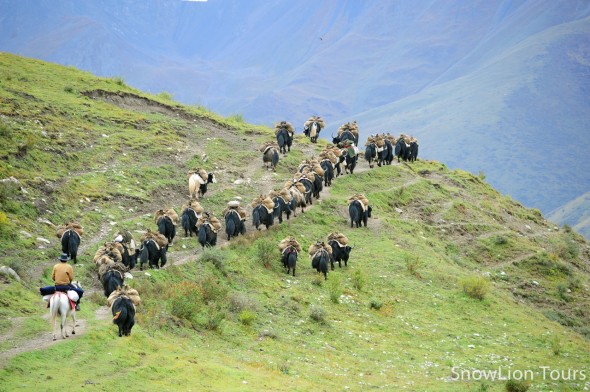The traditional Tibetan region of Amdo, is located on the northeast corner of the Tibetan Plateau. Though most of Amdo lies in modern day Qinghai province, large regions also are located in southwestern Gansu and northern Sichuan provinces. Roughly 1.6 million Tibetans live in Amdo which accounts for over 25% of the total Tibetan population. Amdo is famous for producing some of Tibet’s most famous spiritual leaders including Tsongkhapa, 14th Dalai Lama and the late 10th Panchen Lama. Amdo region is one the most beautiful area of Tibet, 80% of Amdo Tibetans are Nomads. Amdo offers great opportunities for photographing or recording grassland, nomads yak hair tents, snow mountains, lakes, yaks and sheep, blue skype, traditional life style, traditional songs,etc. There are also some famous monasteries in Tibet such as Kumbum Monastery, Rongwu Monastery, Labrang Monastery.etc.
_________________________________________________________________________________________
Labrang/ Xiahe བླ་བྲང
Labrang(Chi: Xiahe) town is sprawls along the banks of Shangchu River(see above picture). It’s an one street town and is predominantly Hui Muslims at the east side of the town and Tibetans at the west end. Labrang Monastery which is one of the Six great Monasteries in Tibet, lays the edge of the west town at the north shore of Sangchu river. The monastery is founded in 1709 by The First Jamyang Gyapa Ngawang Tsondru(1648-1721) who studied at Drepung Monastery in Lhasa. In his age of 53 to 60, he was the abbot of Drepung Gomang monastery in Lhasa. During his study in Lhasa, he received the title”Gamyang Gyapa’(laughing Manjushri), when a statue of Manjushiri(Tib: Jamyang) laughed at his prostrations in the Manjushiri temple in Lhasa. Jamyang Gyapa’s later reincarnations become the abbot of Labrang Monastery since then. His reincarnations are superseded by H.H The Dailai Lama and Panchen Lama, the two highest ranks of Lama in Tibetan Buddhism. Once he returns to Labrang, he founded the great Monastery of Labrang.
Labrang Monastery, this famous monastery in Amdo region of Tibet, it is home to about 1000 monks. There were 3600 monks in it’s peak in 1958. The First Jamyang Gyapa returned to his home town the Gangya grassland in the March 1709 after graduated from Drepung Monastery in Lhasa. He is searching for the monastery location in this area, finally 22nd of April 1709, he chose Labrang as the location of the monastery, thus the monastery refers as Labrang Monastery. The initial constructionof this monastery is a tent monastery, monks live in tents and pray in tents. Later with great support from 8 local tribes, the first 88 pillar of prayer hall is built.
Today Labrang monastery is one of the biggest monastery in Tibet and one of the foremost great monastery for studying Tibetan language and Buddhism. Many Tibetan and Mogolian monks and students come to the monastery for studying and practice Buddhism. There are six colleges(Tib: Dra Tsang) in the monastery which are Tsannyet Dratsang – Buddhism philosophy college, Gyumed Dratsang-Lower Tantra College, Gyuto Dratsang-Uper Tantra College, Menba Dratsang-Medical College, Dukhor Dratang – Kalachakra or artist College and Jaydro-Vajra College.
______________________________________________________________________________________________
Taktsang Lhamo/ Langmusi
Travel from Labrang to the beautiful Tibetan hilly town of Taktsang Lhamo or Langmusi. Two major monasteries (Kirti Monastery and Sertri or sorting Monastery) can be visited. Langmusi is a great place to do a short horse trek or to explore grasslands that are home to nomadic Tibetans. Besides visiting two Monasteries, which was built in the 18th century and houses about 100 monks. You can also take a walk on the grassland and admire the blooming plateau flowers.
______________________________________________________________________________________________
Rebkong/Tongren རེབ་གོང
Rebkong(Tib: རེབ་གོང/reb gong/Repkong/ cn: Tongren), is located in the Golden Valley of the Rongwu Guchu River in Malho (rma lho, Huangnan) prefecture southeast of Qinghai province, The valley is at about 2600m(8500 feet) above sea-level, extends from the north to south, and is surrounded by several mountains. Rebkong is also famous for it’s Tibetan traditional arts and cultural preservation. The there are several large monasteries and villages scattering around the Rongwu town which is home to hundreds of artist. The most well known villages and monasteries are Sanggeshung Yago and Sanggeshung Mago(upper and lower Wutun), Gomar Gompa, Nyamtok village.etc. If you are interested in learning Tibetan culture and Tibetan traditional arts, Rebkong will be one of most recommend region.
Rebkong is one the major Tibetan town in Amdo both in economically and politically. Rebkong has a diverse population of Tibetans, Chinese and Hui, among these ethnic groups, Tibetan population takes about 70% of whole region.
The main attraction of Rebkong are Rongwu Gomchen monastery, upper and lower Sanggeshung monastery and artists village, Nyamtok village, Gomar Monastery and local Tibetan farming homes.
Rongwu Monastery རོང་བོ་དགོན་ཆེན, the largest monastery in Rebkong located at the south end of the town. The monastery is built in 1301 by Lama Samten Renchen. The Monastery has consist of several important temples and colleges. The main temples are The Great Sutra Hall, Main Assembly Hall, The Manjushri Hall.etc. Rongwu Monastery was a Sakya Sect Monastery but later became a Gelug Pa sect of Tibetan buddhism Monastery.
___________________________________________________________________________________________
Golok/Golog/Guoluo མགོ་ལོག
Golok Tibetan Autonomous Prefecture/ མགོ་ལོག་བོད་རིགས་རང་སྐྱོང་ཁུལ: is located in Southeastern of Qinghai Province and Eastern edge of Tibetan Plateau. As it is located in the upper reach of Yellow River, also known as the Source of Yelllow river. Golok is one of the biggest Tibetan Population in Qinghai Province, 90% of population are Tibetan and living in a traditional way of nomadic life style with average altitude 4200m/13450ft. . Golok Tibetan Prefecture consists by 6 counties which are Machen, Gade, Mato, Padma, Jigdril and Darlag. The capital city of Golok is Tawu, which is located 450km south of Xining.
Geographically, Golok is embraced by the mountain Banyakala and Holy Amnye Machen Snow Mountain.
Amnye Machen Snow Mountain/ ཨ་མྱེས་རྨ་ཆེན།
(alt 6282m/20603ft) is located 70km in the southwest of Tawu town of Machen county. Amnye Machen is one of the four main holy mountains of Tibet along with Mt.Kailash, Mt. Minyak Gongga and Mt.Karwa Karpo. It attracts Tibetan pilgrims from across eastern and northern Tibet during the summer months. Especially, the year of sheep in Tibetan calendar, nomads people from Amdo flows here with their families
Amnye Machen is one of the four main holy mountains of Tibet along with Kailash, Gongga and Meili Xue. Located in the northern Tibetan Autonomous Prefecture in Amdo, it rises to 6282m / 20,605 feet. It might be less-known as a holy mountain but it is equally as important to the Tibetan people as the well-known Mt. Kailash and attracts Tibetan pilgrims from all across eastern and northern Tibet during the summer months.
This is an area rich in natural mineral and forest resources and is characterized by vast grasslands covering high mountains and deep valleys. We’ll ride out into this rugged countryside where you often see nomads camping with their herds of yak, horse and sheep and grazing on these grasslands as well as devoted pilgrims on their way to do the 7-10 day holy circumambulation of Amnye Machen.
The Amnye Machen Trek has two options, one is full circumambulation of the mountain which takes 8 days and the other one is 4 days trek in front of the snow mountain. The average trek distance is about 15-16km with 6-7hour per day.







